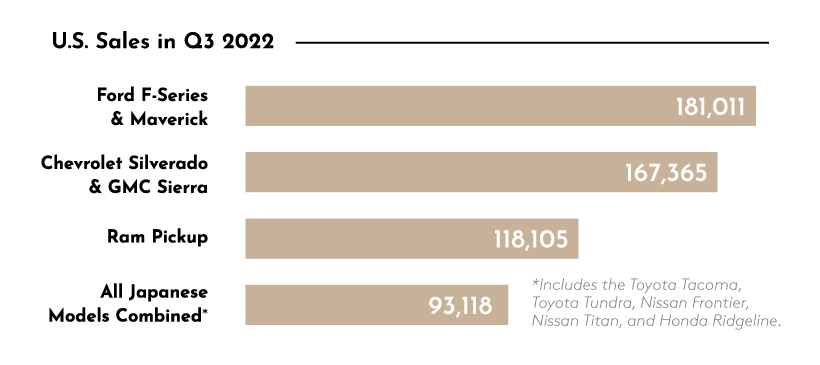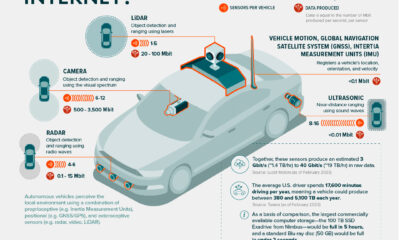Consider this 2006 Honda Civic, which hit one million miles on its original engine and transmission. Amusingly, the car’s odometer maxes out at 999,999 miles. While that case may be an extreme outlier, most modern cars are expected to last 200,000 miles before experiencing some significant failure. That’s roughly double the lifespan of cars from the 1960s and 1970s, which typically lasted about 100,000 miles. In this infographic, we used data from iSeeCars to determine which cars are the most likely to reach— or even surpass—the 200,000 mile benchmark.
Study Methodology & Data
To come up with their rankings, iSeeCars analyzed over 2 million used cars between January and October 2022. The rankings are based on the mileage that the top 1% of cars within each model obtained. Models with less than 10 years of production, such as the Tesla Model 3, were excluded. The following tables show an expanded list of the longest lasting cars, by model category. Our infographic only includes the top five from each.
Sedans & Hatchbacks
The only non-Japanese model in the top 10 is the Chevrolet Impala, which is one of the most commonly found rental cars in the U.S. Another interesting takeaway is that Lexus is the only luxury brand in this list. This is likely due to the fact that Lexus and Toyota often share drivetrain components.
SUVs
iSeeCars has a larger top 20 list for the SUV category. This is a more diverse list, with American and Japanese models seemingly on par. The GM family of SUVs (Tahoe, Suburban, Yukon, and Yukon XL) are narrowly edged out by Toyota’s full size options (Sequoia and Land Cruiser). The Land Cruiser was discontinued in the U.S. for 2021, but it remains a very popular model in Middle Eastern countries like Bahrain, Qatar, and the UAE.
Pickup Trucks
Once again, Japanese manufacturers hold the top spots. According to Toyota, the Tundra is the only full-size pickup that is currently being built in Texas. Despite their marginally higher potential lifespans, sales of Japanese trucks come nowhere close to their American counterparts.
Electric Cars
The last category is EVs, which due to the 10 years of production requirement, only includes the Tesla Model S (133,998 miles) and Nissan LEAF (98,081). These figures are much lower than the gasoline cars discussed above, but it’s not exactly a fair comparison. We probably won’t be able to judge the long-term reliability of EVs until they’ve been around for at least another decade. In addition to needing more time, another reason is scale—the Model S and LEAF have been sold in relatively limited numbers. The Tesla Model 3, which is the first EV to sell over one million units, will likely become the first reliable benchmark. on Even while political regimes across these countries have changed over time, they’ve largely followed a few different types of governance. Today, every country can ultimately be classified into just nine broad forms of government systems. This map by Truman Du uses information from Wikipedia to map the government systems that rule the world today.
Countries By Type of Government
It’s important to note that this map charts government systems according to each country’s legal framework. Many countries have constitutions stating their de jure or legally recognized system of government, but their de facto or realized form of governance may be quite different. Here is a list of the stated government system of UN member states and observers as of January 2023: Let’s take a closer look at some of these systems.
Monarchies
Brought back into the spotlight after the death of Queen Elizabeth II of England in September 2022, this form of government has a single ruler. They carry titles from king and queen to sultan or emperor, and their government systems can be further divided into three modern types: constitutional, semi-constitutional, and absolute. A constitutional monarchy sees the monarch act as head of state within the parameters of a constitution, giving them little to no real power. For example, King Charles III is the head of 15 Commonwealth nations including Canada and Australia. However, each has their own head of government. On the other hand, a semi-constitutional monarchy lets the monarch or ruling royal family retain substantial political powers, as is the case in Jordan and Morocco. However, their monarchs still rule the country according to a democratic constitution and in concert with other institutions. Finally, an absolute monarchy is most like the monarchies of old, where the ruler has full power over governance, with modern examples including Saudi Arabia and Vatican City.
Republics
Unlike monarchies, the people hold the power in a republic government system, directly electing representatives to form government. Again, there are multiple types of modern republic governments: presidential, semi-presidential, and parliamentary. The presidential republic could be considered a direct progression from monarchies. This system has a strong and independent chief executive with extensive powers when it comes to domestic affairs and foreign policy. An example of this is the United States, where the President is both the head of state and the head of government. In a semi-presidential republic, the president is the head of state and has some executive powers that are independent of the legislature. However, the prime minister (or chancellor or equivalent title) is the head of government, responsible to the legislature along with the cabinet. Russia is a classic example of this type of government. The last type of republic system is parliamentary. In this system, the president is a figurehead, while the head of government holds real power and is validated by and accountable to the parliament. This type of system can be seen in Germany, Italy, and India and is akin to constitutional monarchies. It’s also important to point out that some parliamentary republic systems operate slightly differently. For example in South Africa, the president is both the head of state and government, but is elected directly by the legislature. This leaves them (and their ministries) potentially subject to parliamentary confidence.
One-Party State
Many of the systems above involve multiple political parties vying to rule and govern their respective countries. In a one-party state, also called a single-party state or single-party system, only one political party has the right to form government. All other political parties are either outlawed or only allowed limited participation in elections. In this system, a country’s head of state and head of government can be executive or ceremonial but political power is constitutionally linked to a single political movement. China is the most well-known example of this government system, with the General Secretary of the Communist Party of China ruling as the de facto leader since 1989.
Provisional
The final form of government is a provisional government formed as an interim or transitional government. In this system, an emergency governmental body is created to manage political transitions after the collapse of a government, or when a new state is formed. Often these evolve into fully constitutionalized systems, but sometimes they hold power for longer than expected. Some examples of countries that are considered provisional include Libya, Burkina Faso, and Chad.














